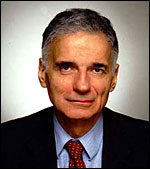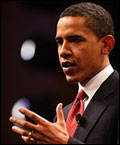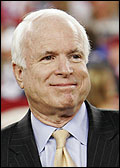Updated 22 Aug 2008
Forget boxers or briefs. You want to know about the presidential candidates’ stances on energy and the environment, right? Well, you’ve come to the right place.
Compare the candidates’ green positions using our handy chart. Get a quick rundown on each candidate below, where you’ll also find links to interviews with them, fact sheets on their records, and more. (And at the bottom of the page are links to info on candidates who’ve dropped out of the race.)
Descriptions of candidates and their positions are not and should not be perceived as endorsements. Grist does not endorse political candidates.
In the early months of Barack Obama‘s presidential campaign, enviros were skeptical of his (now heavily qualified) support for coal-to-liquids technology and unvarnished enthusiasm for ethanol, but he earned their respect with his aggressive climate and energy plan. The plan centers on a cap-and-trade system that aims for 80 percent emission reductions from 1990 levels by 2050 and calls for auctioning 100 percent of the pollution permits. It also includes a $150 billion investment to boost clean energy and create green jobs, along with fine-grained proposals to boost efficiency, build a smart electricity grid, and encourage public transportation. Enviros have also applauded Obama’s refusal to endorse a gas-tax holiday and his now somewhat qualified opposition to offshore oil drilling. Obama earned an 86 percent rating from the League of Conservation Voters for his first three years representing Illinois in the U.S. Senate (a lower score than might have been because he missed some votes while campaigning for president).
- Read Grist’s interview with Obama.
- Read an interview with Obama adviser Jason Grumet.
- Check out a fact sheet on Obama.
- Listen to an audio clip from Grist’s interview with Obama:
John McCain has a mixed record on the environment, but he’s long been outspoken about global warming. He introduced the first major bill in the Senate to address it: the Climate Stewardship Act of 2003, cosponsored with Joe Lieberman. In May 2008, he unveiled a new plan for tackling the problem, a cap-and-trade system with a series of targets for gradually reducing carbon emissions to 60 percent below 1990 levels by the year 2050. The plan would give away many pollution credits instead of auctioning them off, and would give polluting entities expansive leeway to buy carbon offsets instead of reducing their own emissions. McCain used to oppose ethanol subsidies, but upon launching his current presidential campaign, he has changed his tune. He also changed his position on offshore drilling (but he still opposes drilling in the Arctic Refuge). McCain wants to build 45 new nuclear power plants by 2030 and spend big on “clean coal” technology; he also expresses support for wind, solar, and other renewables, but doesn’t believe they need government assistance. The League of Conservation Voters endorsed McCain in his 2004 Senate campaign, despite the fact that he’s gotten low voting scores from the group over the years (including a zero for 2007); McCain’s lifetime LCV score is 24 percent. (This year, LCV endorsed Obama.)
- Read Grist’s interview with McCain.
- Read an interview with McCain adviser Douglas Holtz-Eakin.
- Check out a fact sheet on McCain.
- Listen to an audio clip from Grist’s interview with McCain:

Ralph Nader.
Though Ralph Nader is running as an independent and not under the Green Party banner this time around, he still has some serious small-G green cred (at least among those not still livid over his alleged role in Gore’s 2000 presidential defeat). In the heyday of his consumer advocacy, he and the groups he formed helped get landmark environmental and consumer-protection laws passed, including the Clean Air Act and the Clean Water Act. He has also spent decades fighting nuclear power. These days, Nader regularly decries corporate influence in government and argues against subsidies to nuclear, oil, coal, electric, and biofuels interests. Instead, he calls for heavy investment in solar, wind, and other renewables, as well as in energy efficiency. Nader also advocates for a carbon tax as a way to fight climate change.
- Read Grist’s interview with Nader.
- Check out a fact sheet on Nader.
The path to the presidency is littered with losers, some more sore than others. If you’re wondering what might have been, check out our info on the ex-candidates’ environmental views.
DEMOCRATS
Joe Biden
Hillary Clinton
- interview
- fact sheet
- video from a Grist-sponsored forum
Chris Dodd
John Edwards
- interview
- fact sheet
- video from a Grist-sponsored forum
Mike Gravel
Dennis Kucinich
- interview
- fact sheet
- video from a Grist-sponsored forum
Bill Richardson
Tom Vilsack
REPUBLICANS
Sam Brownback
Rudy Giuliani
Mike Huckabee
Duncan Hunter
Ron Paul
Mitt Romney
Tom Tancredo
Fred Thompson



